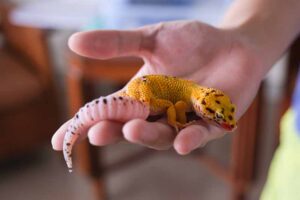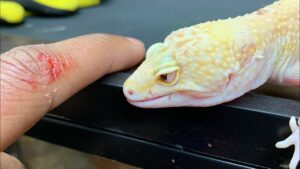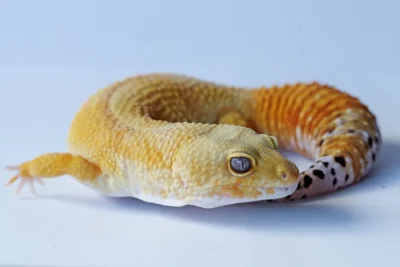Do Leopard Geckos Bite? This question often arises among reptile enthusiasts and prospective pet owners alike. Leopard geckos (Eublepharis macularius) are popular choices for reptile enthusiasts due to their docile nature, manageable size, and captivating appearance.
However, like any animal, they possess natural behaviors, including the potential to bite. Understanding the circumstances surrounding leopard gecko bites, as well as their temperament and care requirements, is crucial for fostering a positive and safe interaction with these fascinating creatures. Let’s delve into the world of leopard geckos and explore the intricacies of their biting behavior.
Understanding Leopard Gecko Behavior

Leopard geckos, like many reptiles, have their own unique behaviors that can be fascinating to observe. Here are some common behaviors and what they might mean:
- Tail Wagging: Leopard geckos often wag their tails, especially during hunting or when they feel threatened. If they are hunting, it’s a sign of excitement. However, if they feel threatened or stressed, tail wagging can be a defensive behavior.
- Basking: Leopard geckos require a heat source to regulate their body temperature. Basking under a heat lamp or heat pad is common behavior, especially after a meal when they need to digest their food.
- Hiding: Leopard geckos are nocturnal animals and naturally seek shelter during the day. Providing hiding spots in their enclosure, such as caves or hollow logs, allows them to feel secure.
- Glass Surfing: When a leopard gecko repeatedly runs along the glass walls of its enclosure, it might indicate stress or a desire to explore beyond its current space. Check the temperature, humidity, and overall environment to ensure it’s appropriate for your gecko.
- Hunting: Leopard geckos are skilled hunters and will actively search for prey items like crickets or mealworms. Watching them stalk and catch their prey can be quite entertaining.
- Tail Loss (Autotomy): If a leopard gecko feels threatened, it might drop its tail as a defense mechanism. The detached tail will wiggle, distracting the predator while the gecko escapes. It’s essential to provide a stress-free environment to minimize the likelihood of this happening.
- Biting: While leopard geckos are generally docile, they might bite if they feel threatened or if they mistake your hand for food. Handling them gently and with care can help build trust and minimize the risk of bites.
Understanding these behaviors can help you provide the best care for your leopard gecko and ensure they live a happy and healthy life. Regular observation and interaction will also help you better understand your gecko’s individual personality and preferences.
Reasons Why Leopard Geckos Might Bite
Leopard geckos are generally docile creatures, but there are several reasons why they might bite:
- Mistaking for Food: Leopard geckos have poor eyesight, and they might mistake your hand or fingers for food, especially if they’re hungry or if you have food scent on your hands.
- Feeling Threatened: Like many animals, leopard geckos may bite if they feel threatened or cornered. This could happen if you handle them too roughly or if they’re stressed by their environment.
- Protecting Territory: If you invade their territory or handle them in a way that makes them feel uncomfortable, they may react defensively by biting.
- Pain or Discomfort: If a leopard gecko is in pain or discomfort due to an injury, illness, or improper husbandry conditions, they may bite as a defensive response.
- Stress or Agitation: Leopard geckos can become stressed or agitated due to changes in their environment, such as sudden loud noises, bright lights, or frequent disturbances.
- Mating Season Aggression: During the breeding season, male leopard geckos may become more territorial and aggressive towards other males, females, or even humans.
- Inexperience or Mishandling: If you’re inexperienced in handling leopard geckos or if you mishandle them, they may bite out of fear or confusion.
It’s essential to handle leopard geckos gently and with care to minimize the risk of biting. Providing a stress-free environment with appropriate hiding spots, temperature, and humidity levels can also help prevent aggressive behaviors. If you’re unsure why your leopard gecko is biting, it’s a good idea to consult with a reptile veterinarian or experienced reptile keeper for advice.
Signs of Aggression in Leopard Geckos

While leopard geckos are generally known for their docile nature, they can exhibit signs of aggression, especially during mating season or when feeling threatened. Here are some common signs of aggression in leopard geckos:
- Tail Wagging: While tail wagging can also indicate excitement or hunting behavior, rapid and aggressive tail wagging, especially when paired with other defensive behaviors, can signal aggression.
- Hissing: Leopard geckos may hiss when they feel threatened or agitated. It’s a warning sign that they may bite if the perceived threat persists.
- Open Mouth Display: Similar to hissing, leopard geckos may open their mouths wide as a defensive display, showing their teeth in an attempt to intimidate a perceived threat.
- Biting: Aggressive leopard geckos may bite if they feel cornered, threatened, or if they perceive you as a threat to their territory.
- Chasing or Lunging: Some leopard geckos may exhibit aggressive behavior by chasing or lunging at other geckos, especially during mating season when males may compete for dominance.
- Puffing Up: When feeling threatened, leopard geckos may puff themselves up to appear larger and more intimidating to potential threats.
- Blocking or Guarding Territory: Aggressive leopard geckos may block access to certain areas of their enclosure or guard their hiding spots, food, or mate aggressively.
- Refusal to Eat or Drink: If a leopard gecko is consistently refusing to eat or drink, it could be a sign of stress or aggression, especially if accompanied by other defensive behaviors.
- Glass Surfing: While not always a sign of aggression, leopard geckos may engage in glass surfing when they feel stressed or agitated, which could be due to perceived threats or changes in their environment.
It’s essential to understand the signs of aggression in leopard geckos to prevent stress and potential injuries to both the geckos and their caregivers. Providing a stress-free environment with proper hiding spots, temperature, and humidity levels can help minimize aggressive behaviors. If aggression persists, it’s best to consult with a reptile veterinarian or experienced reptile keeper for further advice and guidance.
Preventing Leopard Gecko Bites
Preventing leopard gecko bites requires understanding their behavior and taking appropriate precautions. Here are some tips to help you avoid getting bitten by your leopard gecko:
- Handle Gently: Always handle your leopard gecko gently and with care. Avoid sudden movements or grabbing them forcefully, as this can startle or stress them, increasing the likelihood of a defensive bite.
- Wash Your Hands: Before handling your leopard gecko, wash your hands thoroughly to remove any scents of food or other substances that might trigger a feeding response.
- Approach Slowly: When approaching your gecko, do so slowly and from the side rather than from above. This helps them feel less threatened and reduces the chances of them reacting defensively.
- Respect Their Space: Give your leopard gecko space and avoid invading their territory unnecessarily. If they retreat into their hide, respect their need for privacy and don’t try to force them out.
- Avoid Handling During Stressful Times: Try to avoid handling your leopard gecko during stressful times, such as when they are shedding, after feeding, or during mating season. Give them time to rest and settle before attempting to handle them.
- Watch for Warning Signs: Pay attention to your gecko’s body language. If they show signs of stress, such as hissing, tail wagging, or puffing up, it’s best to give them some space rather than risk getting bitten.
- Use a Soft Touch: When handling your leopard gecko, use a soft touch and avoid squeezing or restraining them too tightly. Support their body properly to make them feel secure and comfortable.
- Build Trust: Spend time with your leopard gecko regularly to build trust and familiarity. The more comfortable they are with you, the less likely they’ll be to bite.
- Be Prepared: Have a plan in place in case your leopard gecko does bite. Stay calm and gently disengage from the bite without jerking away, as this can cause further stress or injury.
- Seek Professional Help if Needed: If you’re struggling to handle your leopard gecko safely or if they continue to exhibit aggressive behavior, consider seeking advice from a reptile veterinarian or experienced reptile keeper for further guidance.
By following these tips and respecting your leopard gecko’s boundaries, you can minimize the risk of getting bitten and ensure a positive interaction for both you and your pet.

What to Do If Bitten
If you find yourself bitten by your leopard gecko, here’s what you should do:
- Stay Calm: It’s natural to feel startled or alarmed if you’re bitten, but try to remain calm. Sudden movements or panic can stress your gecko further.
- Don’t Pull Away: Avoid pulling your hand away quickly, as this can potentially injure your gecko’s teeth or cause further damage. Instead, gently and slowly try to release your hand from their grip.
- Assess the Wound: Once you’ve been able to remove your hand from the gecko’s mouth, assess the wound. Leopard gecko bites are usually not severe, but they can cause minor puncture wounds or scratches.
- Clean the Wound: Wash the affected area with mild soap and warm water to reduce the risk of infection. You may also apply an antiseptic or antibiotic ointment to the wound if necessary.
- Monitor for Signs of Infection: Keep an eye on the wound for any signs of infection, such as redness, swelling, warmth, or pus. If you notice any concerning symptoms, seek medical attention.
- Treat Pain and Discomfort: If the bite is painful or uncomfortable, you can take over-the-counter pain relievers such as ibuprofen or acetaminophen, following the recommended dosage instructions.
- Observe Your Gecko: After the incident, observe your leopard gecko for any signs of stress or injury. Ensure they have a quiet and comfortable environment to rest and recover.
- Reflect on the Incident: Consider what might have triggered the bite and how you can prevent similar incidents in the future. Reflect on your handling techniques and whether there were any factors that contributed to your gecko feeling threatened or stressed.
- Seek Veterinary Advice if Necessary: If the bite is severe, or if you have concerns about your gecko’s health or behavior following the incident, consult with a reptile veterinarian for further guidance.
Remember that leopard gecko bites are typically not serious and rarely cause significant harm. However, it’s essential to take appropriate precautions to minimize the risk of getting bitten and to handle any bites properly to prevent infection or complications.
Conclusion
On this page, you can get answers to the question do Leopard Geckos Bite. While leopard geckos are generally docile pets, they may bite under certain circumstances. It’s essential to handle them gently, respect their boundaries, and be aware of potential triggers for aggression.
With proper care and handling, the risk of getting bitten by a leopard gecko can be minimized, ensuring a positive experience for both the owner and the pet.

